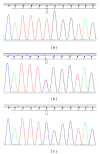Rhabdomyolysis and Cardiomyopathy in a 20-Year-Old Patient with CPT II Deficiency
- PMID: 24563797
- PMCID: PMC3915840
- DOI: 10.1155/2014/496410
Rhabdomyolysis and Cardiomyopathy in a 20-Year-Old Patient with CPT II Deficiency
Abstract
Aim. To raise the awareness of adult-onset carnitite palmitoyltransferase II deficiency (CPT II) by describing clinical, biochemical, and genetic features of the disease occurring in early adulthood. Method. Review of the case characteristics and literature review. Results. We report on a 20-year-old man presenting with dyspnea, fatigue, fever, and myoglobinuria. This was the second episode with such symptoms (the previous one being three years earlier). The symptoms occurred after intense physical work, followed by a viral infection resulting in fever treated with NSAIDs. Massive rhabdomyolysis was diagnosed, resulting in acute renal failure necessitating plasmapheresis and hemodialysis, acute hepatic lesion, and respiratory insufficiency. Additionally, our patient had cardiomyopathy with volume overload. After a detailed workup, CPT II deficiency was suspected. We did a sequencing analysis for exons 1, 3, and 4 of the CPT II gene and found that the patient was homozygote for Ser 113 Leu mutation in exon 3 of the CPT II gene. The patient recovery was complete except for the cardiomiopathy with mildly impaired systolic function. Conclusion. Whenever a patient suffers recurrent episodes of myalgia, followed by myoglobinuria due to rhabdomyolysis, we should always consider the possibility of this rare condition. The definitive diagnose of this condition is achieved by genetic testing.
Figures
Similar articles
-
Carnitine Palmitoyltransferase II Deficiency (CPT II) Followed By Rhabdomyolysis and Acute Kidney Injury.Open Access Maced J Med Sci. 2018 Apr 12;6(4):666-668. doi: 10.3889/oamjms.2018.158. eCollection 2018 Apr 15. Open Access Maced J Med Sci. 2018. PMID: 29731937 Free PMC article.
-
Myopathic Carnitine Palmitoyltransferase II (CPT II) Deficiency: A Rare Cause of Acute Kidney Injury and Cardiomyopathy.Cureus. 2023 Oct 6;15(10):e46595. doi: 10.7759/cureus.46595. eCollection 2023 Oct. Cureus. 2023. PMID: 37933340 Free PMC article.
-
Rhabdomyolysis Associated with Recent SARS-COV-2 Infection in a Patient with Carnitine Palmitoyltransferase II Deficiency.Pril (Makedon Akad Nauk Umet Odd Med Nauki). 2022 Dec 4;43(3):61-66. doi: 10.2478/prilozi-2022-0037. Print 2022 Nov 1. Pril (Makedon Akad Nauk Umet Odd Med Nauki). 2022. PMID: 36473042
-
Muscle Carnitine Palmitoyltransferase II Deficiency: A Review of Enzymatic Controversy and Clinical Features.Int J Mol Sci. 2017 Jan 3;18(1):82. doi: 10.3390/ijms18010082. Int J Mol Sci. 2017. PMID: 28054946 Free PMC article. Review.
-
Muscle Carnitine Palmitoyltransferase II (CPT II) Deficiency: A Conceptual Approach.Molecules. 2020 Apr 13;25(8):1784. doi: 10.3390/molecules25081784. Molecules. 2020. PMID: 32295037 Free PMC article. Review.
Cited by
-
Circulatory response to exercise relative to oxygen uptake assessed in the follow-up of patients with fatty acid beta-oxidation disorders.J Inherit Metab Dis. 2025 Jan;48(1):e12819. doi: 10.1002/jimd.12819. Epub 2024 Dec 9. J Inherit Metab Dis. 2025. PMID: 39648745 Free PMC article.
-
Exertional rhabdomyolysis leading to acute kidney injury: when genetic defects are diagnosed in adult life.CEN Case Rep. 2018 May;7(1):62-65. doi: 10.1007/s13730-017-0292-z. Epub 2017 Dec 12. CEN Case Rep. 2018. PMID: 29234986 Free PMC article.
-
Carnitine Palmitoyltransferase II Deficiency (CPT II) Followed By Rhabdomyolysis and Acute Kidney Injury.Open Access Maced J Med Sci. 2018 Apr 12;6(4):666-668. doi: 10.3889/oamjms.2018.158. eCollection 2018 Apr 15. Open Access Maced J Med Sci. 2018. PMID: 29731937 Free PMC article.
-
Clinical manifestations and management of fatty acid oxidation disorders.Rev Endocr Metab Disord. 2020 Dec;21(4):479-493. doi: 10.1007/s11154-020-09568-3. Rev Endocr Metab Disord. 2020. PMID: 32654032 Free PMC article. Review.
References
-
- Hogan KJ, Vladutiu GD. Malignant hyperthermia-like syndrome and carnitine palmitoyltransferase II deficiency with heterozygous R503C mutation. Anesthesia and Analgesia. 2009;109(4):1070–1072. - PubMed
-
- Bonnefont J-P, Djouadi F, Prip-Buus C, Gobin S, Munnich A, Bastin J. Carnitine palmitoyltransferases 1 and 2: biochemical, molecular and medical aspects. Molecular Aspects of Medicine. 2004;25(5-6):495–520. - PubMed
-
- Sigauke E, Rakheja D, Kitson K, Bennett MJ. Carnitine palmitoyltransferase II deficiency: a clinical, biochemical, and molecular review. Laboratory Investigation. 2003;83(11):1543–1554. - PubMed
-
- Pagon RA, Bird TD, Dolan CR, et al. GeneReviews [Internet] Seattle, Wash, USA: University of Washington; 2004. Carnitine palmytoiltransferase II deficiency; pp. 1993–2013.
-
- Deschauer M, Wieser T, Zierz S. Muscle carnitine palmitoyltransferase II deficiency: clinical and molecular genetic features and diagnostic aspects. Archives of Neurology. 2005;62(1):37–41. - PubMed
LinkOut - more resources
Full Text Sources
Other Literature Sources



